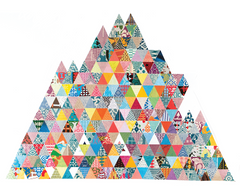DRAWING ALGORITHM: Begin with 1cm horizontal line drawn in 7 colors, stacked vertically in top left corner. Move horizontally & follow with 1cm vertical line in 7 colors, stacked horizontally. Move horizontally & follow with 1cm horizontal line in 7 colors stacked vertically. Move Vertically & follow with 1cm vertical line in 7 colors stacked horizontally & REPEAT 
This simple (albeit made up) example of a visual algorithm shows how an image can be created using the same self-imposed, predetermined sets of rules or algorithms used in the mathematical calculations that drive things like computer programs. When combined with an artist’s hand and a certain amount of unpredictability, generative art can produce some stunning results. TWFA’s Briony Barr has collaborated with physicist Andrew Melatos in Drawing on Complexity, an initiative that creates ‘art experiments’ in the form of large-scale, rule based floor drawings made by groups of participants using colored electrical (PVC) tape. Barr and Melatos invite external participants to create a drawing based on a set of devised rules. The artists do not direct the drawing process, instead they let the participants (agents) create the artwork just as much as the rules they are following. Over time, the interactions between the agents and the rules accumulate to create ripple effects that feed back into the artwork (or system) changing it's course. This happens over and over again, making the drawing complex and unpredictable. The artists document their work in time lapsed video with a written account of the project that is then uploaded to their website. This month the pair coordinate Drawing/Undrawing at NGV community hall in Melbourne. Stay tuned for future projects and be sure to check it out and contribute! Below is the pairs documentation for Experiment #4 at the National Museum of Modern & Contemporary Art in Seoul. Experiment #4 Duration: 5 hours Agents: 24 Size: 12 x 12 m Location: The National Museum of Modern and Contemporary Art, Seoul, South Korea Date: 2013 The drawing was structured using an underlying pencil grid, providing two ways for the different agents to move around; on top of the lines articulating the grid (S1) or inside each grid square (S2). In phase one of the drawing, we allowed agents to have only four ‘children’ (four collaborations) before moving on. In phase two, agents working together were allowed to combine their genetic material as many times as they wanted. This rule variation resulted in many agent duos choosing to have rather a lot of ‘children’. In almost every drawing experiment we see this tendency towards the most efficient way of doing something. In the case of Experiment #4, working as a couple over a longer period of time, repeating the same act, means better strategies can be developed for getting things done (i.e. making a collaborative drawing). This is common sense and also a fundamental tendency of nature; to take the most energy efficient route. 








Comments on post (0)
Leave a comment